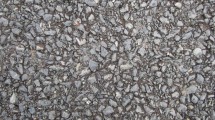Abstract
Pavement surface friction is a significant factor for driving safety and plays a critical role in reducing wet-pavement crashes. However, the current asphalt mixture design procedure does not directly consider friction as a requirement. The objective of this study was to develop a surface friction prediction model that can be used during a wearing course mixture design. To achieve the objective, an experimental study was conducted on the frictional characteristics of typical wearing course mixtures in Louisiana. Twelve wearing course mixtures including dense-graded and open-graded mixes with different combinations of aggregate sources were evaluated in laboratory using an accelerated polishing and testing procedure considering both micro-and macro texture properties. In addition, the surface frictional properties of asphalt mixtures were measured on twenty-two selected asphalt pavement sections using different in situ devices including Dynamic Friction Tester (DFT), Circular Texture Meter (CTM), and Lock-Wheel Skid Trailer (LWST). The results have led to develop a procedure for predicting pavement end-of-life skid resistance based on the aggregate blend polish stone value, gradation parameters, and traffic, which is suited in checking whether the selected aggregates in a wearing course mix design would meet field friction requirements under a certain design traffic polishing.
Similar content being viewed by others
References
Blincoe L J, Miller T R, Zaloshnja E, Lawrence B A. The Economic and Societal Impact of Motor Vehicle Crashes, 2010. Report No. DOT HS 812 013. Washington, DC: National Highway Traffic Safety Administration, 2014
Kuemmel D A, Sontag R C, Crovetti J A, Becker Y, Jaeckel J R, Satanovsky A. Noise and Texture on PCC Pavements. Final report multi state study. Report Number WI/SPR-08-99, Wisconsin Department of Transportation, Kinsman Blvd., Madison, WI, 2000
Noyce D A, Bahia H U, Yamb J M, Kim G. Incorporating Road Safety into Pavement Management: Maximizing Asphalt Pavement Surface Friction for Road Safety Improvements. Draft Literature Review and State Surveys, Midwest regional University Transportation Center, Traffic Operations and Safety (TOPS) Laboratory. Apr. 29, 2005
Masad E, Rezaei A, Chowdhury A, Harris P. Predicting Asphalt Mixture Skid Resistance Based on Aggregate Characteristics. Texas Transportation Institute, The Texas A&M University System College Station, Texas, 77843, 2009
Hall JW, Smith K L, Titus-Glover L,Wambold J C, Yager T J, Rado Z. Guide for Pavement Friction. NCHRP Project 1-43. National Cooperative Highway Research Program, Transportation Research Board, National Research Council, Washington, D.C., 2009
Dewey G R, Robords A C, Armour B T, Muethel R. Aggregate Wear and Pavement Friction. Presented at 80th Transportation Research Board Annual Meeting, Washington, D.C., 2001
Hogervorst D. Some properties of crushed stone for road surfaces. Bulletin of Engineering Geology and the Environment, 1974, 10(1): 59–64 (Springer)
Rose J G, Gallaway B M. Macrotexture Measurement and Related Skid Resistance at Speeds from 20 to 60 Miles per Hour. Transportation Research Record 341, Transportation Research Board, TRB, National Research Council, Washington, D.C., 1970
Ashby J T. Blended Aggregate Study. LTRC final report 145, Baton Rouge, 1980
Bloem D L. Skid-Resistance: The Role of Aggregates and Other Factors. National Sand and Gravel Association Circular 109, Silver Spring, MD, 1971
Wu Z, King B. Developments of Surface Friction Guidelines for DOTD FHWA/La.011/485. Louisiana Transportation Research Center, Baton Rouge, 2012
Vollor T W, Hanson D I. Development of Laboratory Procedure for Measuring Friction of HMA Mixtures-Phase 1. NCAT Report 06-06, National Center of Asphalt Technology, Auburn University, AL, 2006
Wambold J C, Antle C E, Henry J J, Rado Z. PIARC (Permanent International Association of Road Congress) Report. International PIARC Experiment to Compare and Harmonize Texture and Skid Resistance Measurement, C-1 PIARC Technical Committee on Surface Characteristics, France, 1995
Masad E, Rezaei A, Chowdhury A, Harris P. Field Evaluation of Asphalt Mixture Skid Resistance and Its Relationship to Aggregate Characteristics. Texas Transportation Institute, The Texas A&M University System College Station, Texas 77843, 2010
Acknowledgments
This study was supported by the Louisiana Transportation Research Center (LTRC) and the Louisiana Department of Transportation and Development (LADOTD). The authors would like to express thanks to all those who provided valuable help in this study.
Author information
Authors and Affiliations
Corresponding author
Rights and permissions
About this article
Cite this article
Wu, Z., Abadie, C. Laboratory and field evaluation of asphalt pavement surface friction resistance. Front. Struct. Civ. Eng. 12, 372–381 (2018). https://doi.org/10.1007/s11709-017-0463-1
Received:
Accepted:
Published:
Issue Date:
DOI: https://doi.org/10.1007/s11709-017-0463-1




